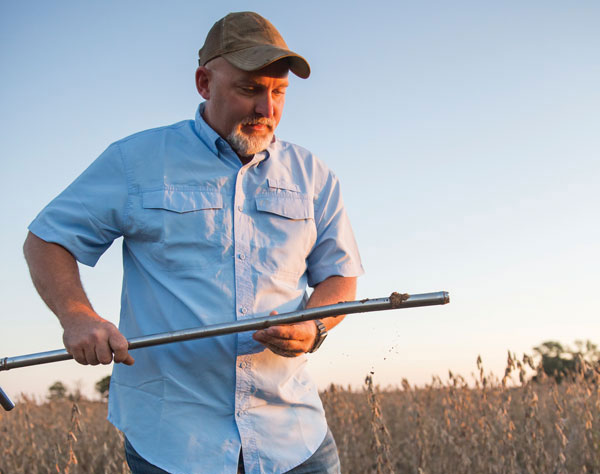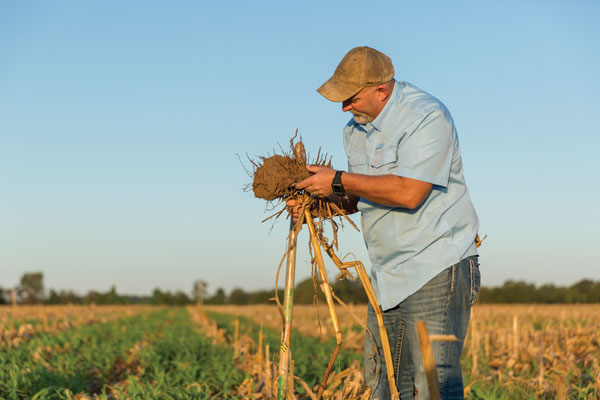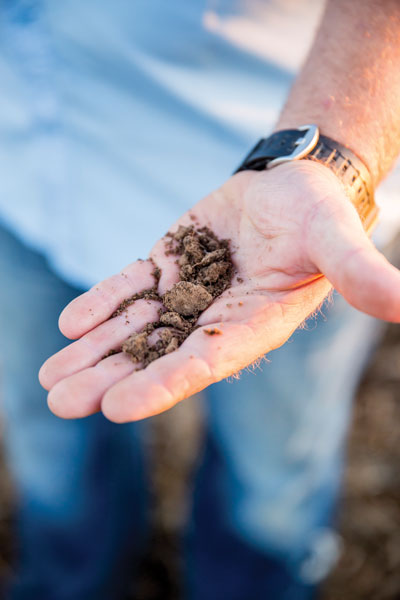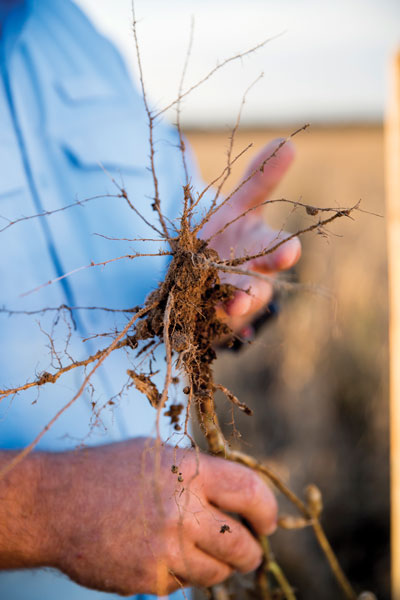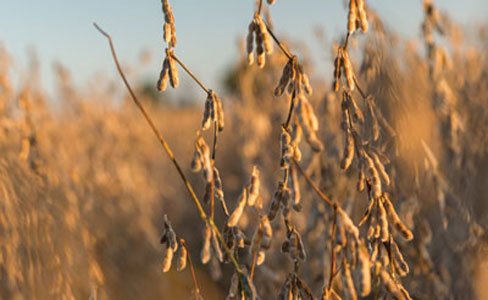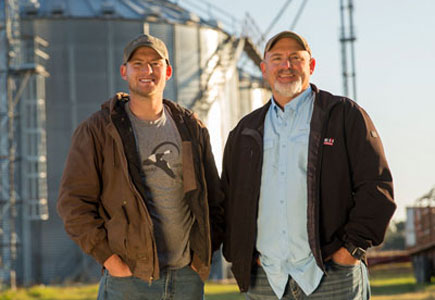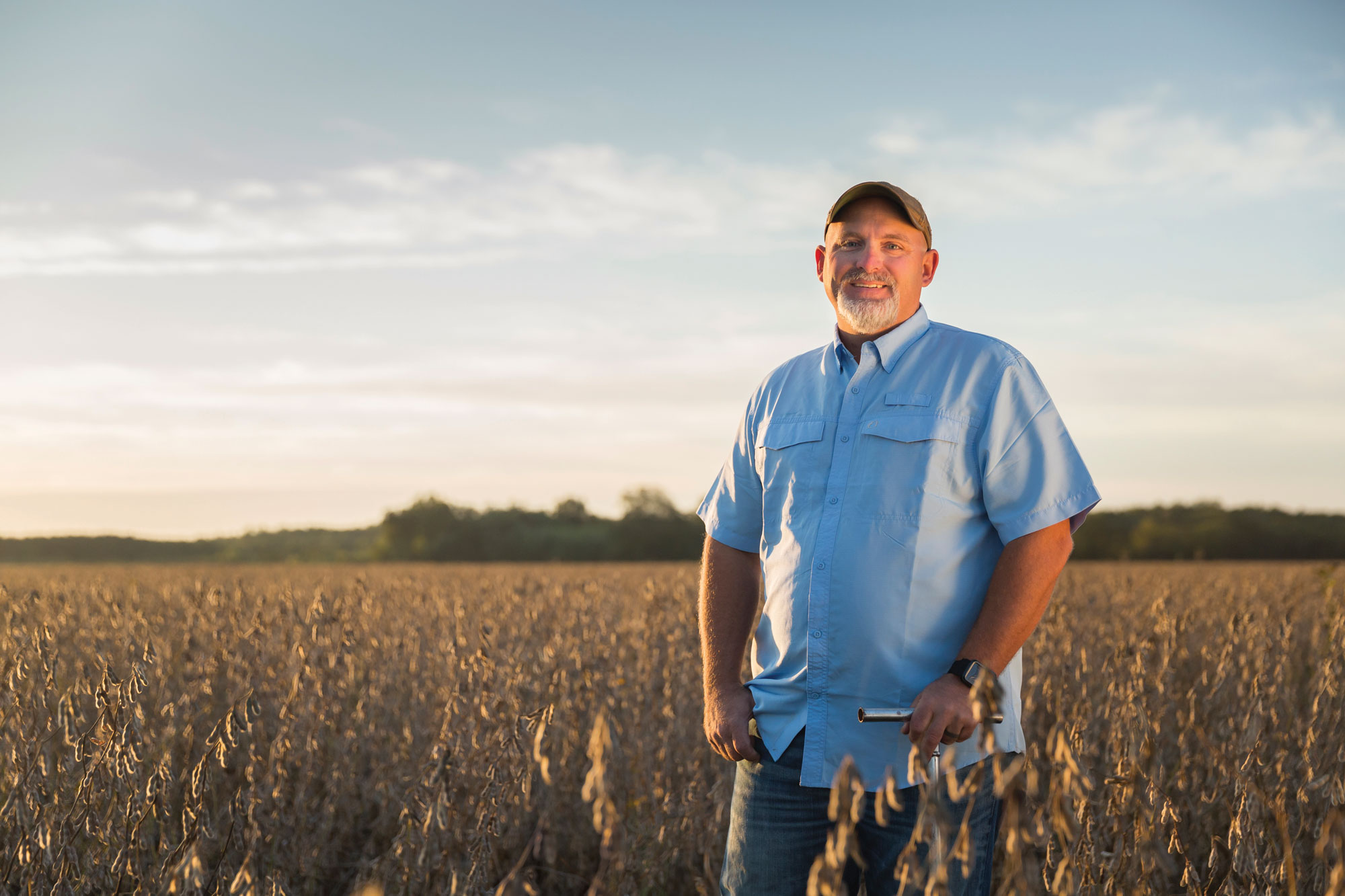
Saving the Soil
October 5, 2019
Written By Adam Buckallew
Cover Crops Aid Arkansas Farmer in Sustaining His Land
Standing in a field of his soon-to-be-harvested soybeans about a half-hour’s drive east of Little Rock, Ark., Robby Bevis plunges a steel soil probe into the ground. As the morning sun crests the horizon, he dumps the collected dirt into his hand. “This is the foundation of all agriculture,” he says while sifting the sandy loam soil through his fingers. “And we should be doing a better job of protecting it.”
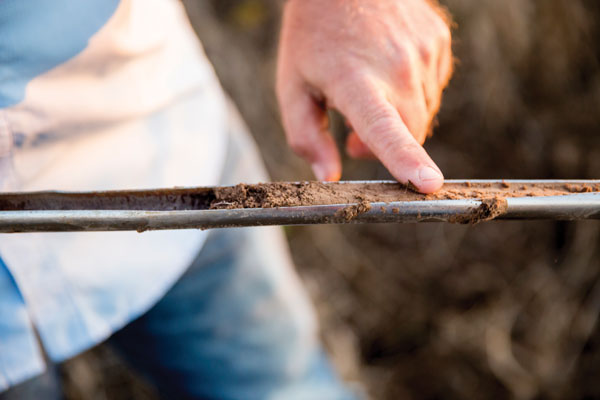
Anytime Bevis sees heavy tillage or chocolate-milk colored water washing off a farm field, it pains him. He knows how crucial the topsoil lost to erosive forces is to any farm’s chances of future success and how long it takes to replace what is lost.
Giving Dirt its Due
The soil Bevis is holding in his hands isn’t just some inanimate lump of earth. It’s part of a complex and diverse microbiome that is teeming with life—much of it microscopic—like bacteria, viruses and fungi that coexist with worms, nematodes, springtails, insects and plant roots. A single gram of fertile soil can contain up to a billion bacteria.
Each microorganism and subterranean critter plays its own special role in building sustainable soils including mineralizing nutrients for plant uptake, decomposing plant residue, stimulating root growth, biologically controlling soil pathogens, providing structure and much more. When a soil’s underground life is flourishing, it provides nourishment for plants and absorbs and retains water to help minimize the effects of droughts and flooding. But when the earth is plowed up or left barren in between crops, the dirt-bound organisms begin to die off and the soil becomes degraded.
When Bevis began to learn of the unseen and underappreciated life beneath his fields—and the role it plays in maintaining the productivity of his land—he knew things had to change on his farm. He now follows three core soil health principles: keep living roots in the ground, diversify the types of plants that grow in it and disturb it as little as possible.
Incorporating Cover Crops
Bevis’s interest in preserving and restoring his soils can be traced back to his decision to add 900 acres of winter cover crops to his farmland in 2012. The fifth-generation grower, who farms with his son, Trey, and his father, Bob, is well-acquainted with raising corn, soybeans and rice on the edge of the Arkansas Delta. But cover crops were a relative unknown to him. The first year had its challenges, but Bevis learned much from the experience.
In the summer following his initial experimentation, he noticed the fields that had been planted with cover crops needed less irrigation, cutting his water pumping expenses. That was enough to convince him to plant cover crop seed across the majority of his 3,000 acres following the 2010 harvest, and in the years since, he’s realized further benefits.
Bevis’s cover crops have not only kept his soils in place but also improved the soil’s structure, boosted its organic matter levels, and increased its water-holding capacity.
On some of his farms, Bevis has increased the organic matter in the soil from 0.5 percent up to between 3 and 4 percent, and it’s still ticking up. Soil scientists report that for every 1 percent of organic matter, the soil can hold 20,000 gallons of plant-available water per acre of soil in the top foot of soil.
Building the land’s organic matter deposits has allowed Bevis to cut his irrigations costs in half and drastically reduce his field’s fertility needs. He has slashed his corn’s fertilizer inputs and didn’t apply any phosphorus or potassium to his 2018 soybean crop—resulting in substantial savings with no reduction in yield.
“All our inputs across the board are down,” Bevis says. “We’re now trying to see how low we can go.”
Keeping Soil Covered
As soon as he finishes the fall harvest, Bevis plants a multispecies mix of cover crops that varies based on his cash crop rotation. At minimum, he plants a three-way blend of cover crops to maximize the diversified benefits each plant species brings to the table. Every mixture always includes a grass, a brassica and legume.
Grasses are effective at scavenging nitrogen in the soil and leaving behind plenty of plant residue that helps to build organic matter and suppress weeds. Brassica provide rapid fall growth to minimize soil exposure after harvest and often have long taproots that drill down several feet helping to break up compacted soils. Legumes fix atmospheric nitrogen in the soil while improving organic matter and soil structure.
In soybean fields that will be planted to corn the following season, Bevis plants cereal rye, black oats, Austrian winter peas, clover, vetch and a radish variety. Adding three legumes to the mix helps build sufficient nitrogen for his corn crop, and he appreciates the way vetch will help push the grasses down in the spring when he’s ready to plant his cash crop into the standing cover.
Touting Soil Health
Bevis’s experience with cover crops has completely reshaped his views on farming and his strategy for the future.
“If you would have asked me prior to 2012 if I would be talking about stuff like cover crops, nutrient cycling, and soil health, I would have told you, ‘No, that’s not me,’” he says. “But the more I’ve stepped back and looked at it, the more I’ve realized the soil is the key.”
In an effort to help other farmers preserve and unlock the potential in their soils, Bevis and like-minded growers formed the Arkansas Soil Health Alliance.
“We know there are a lot of people who are struggling with soil health questions and how they can incorporate cover crops and other practices into their operations,” says Bevis, who serves as the non-profit’s president. “We want to help people avoid some of the mistakes we made and dispel some of the myths and misinformation that’s out there.”
Cost is a common concern many farmers share with Bevis when considering jumping into cover cropping. Bevis says that’s no surprise given the low levels of profitability in farming at the moment. His annual investment on his cover crops is typically $25 per acre, which Bevis says isn’t much compared to the $75 to $100 an acre many farmers in his area will spend on tillage.
“Everyone is looking to save money anywhere they can, but you have to look at the bigger picture,” Bevis says.
“I honestly don’t think we can continue to farm the way we have been and hope to maintain our sustainability.”
Protecting the Future
While Bevis is confident in the results he has seen from growing cover crops, he’s working with researchers with the University of Arkansas Discovery Farms Program to conduct water infiltration studies, measure soil quality, and test nitrogen application rates on his farms in an effort to provide verifiable data that could benefit other growers.
This fall, scientists will be burying moistures sensors at varying depths in the soil at Bevis’s farms.
“We know our infiltration has gotten better,” Bevis says. “We can catch a two-to-three-inch rain without any runoff. We are also seeing water get down to 30-inch depths within 36 hours following a rain.”
Bevis hopes the researchers will be able to identify best practices and economic models that will encourage other farmers to make cover cropping part of their crop management routine.
“It takes some patience and may cause some head turning with your neighbors, but it’s worth it,” Bevis says. “We want to build the soil back up and be proud of the land that we pass on to the next generation.”



